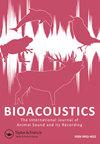Using autonomous recording units and change-point analysis to determine reproductive activity in an aerial insectivore
IF 2.1
4区 生物学
Q2 ZOOLOGY
Bioacoustics-The International Journal of Animal Sound and Its Recording
Pub Date : 2021-05-10
DOI:10.1080/09524622.2021.1921617
引用次数: 1
Abstract
ABSTRACT Autonomous Recording Units (ARUs) are commonly used, alongside traditional methods, to study the presence/absence of vocal species. ARUs are useful in monitoring species that are secretive or vocalise at night. We endeavoured to develop a method to monitor avian reproductive activity using ARUs. Olive-sided flycatchers (Contopus cooperi), an at-risk passerine, are an ideal species with which to develop this method as they have a loud distinct call and have large territories without much intrusion from conspecifics. Olive-sided flycatchers have a distinct call pattern during the breeding season. We used a change-point analysis to determine the dates of significant changes in their call pattern to determine if individuals were successfully breeding. We monitored 22 Olive-sided flycatchers in central New Brunswick in 2018 and 2019. We found that using a combination of ARUs and change-point analyses was a viable method for studying reproductive activity of Olive-sided flycatchers. We found that 27% of Olive-sided flycatchers were successfully breeding which, when considering erroneous classifications, is within the range of nest success (30–65%) documented elsewhere. Our method shows promise for studying other bird species as well as other vocal non-avian species.利用自主记录单元和变化点分析确定食虫昆虫的生殖活动
摘要自主记录单元(ARU)通常与传统方法一起用于研究发声物种的存在/不存在。ARU可用于监测夜间隐秘或发声的物种。我们努力开发一种使用ARU监测鸟类繁殖活动的方法。橄榄边捕蝇草(Contopus cooperi)是一种有风险的雀形目,是开发这种方法的理想物种,因为它们有着响亮而独特的叫声,并且有很大的领地,没有太多来自同种的入侵。橄榄边捕蝇草在繁殖季节有着明显的叫声模式。我们使用变化点分析来确定它们的叫声模式发生重大变化的日期,以确定个体是否成功繁殖。2018年和2019年,我们在新不伦瑞克省中部监测了22只橄榄边捕蝇草。我们发现,使用ARU和变化点分析相结合的方法是研究橄榄侧捕蝇繁殖活动的可行方法。我们发现,27%的橄榄边捕蝇草成功繁殖,当考虑到错误的分类时,这在其他地方记录的巢穴成功范围内(30-65%)。我们的方法有望研究其他鸟类以及其他发声的非鸟类。
本文章由计算机程序翻译,如有差异,请以英文原文为准。
求助全文
约1分钟内获得全文
求助全文
来源期刊
CiteScore
4.50
自引率
0.00%
发文量
25
审稿时长
>12 weeks
期刊介绍:
Bioacoustics primarily publishes high-quality original research papers and reviews on sound communication in birds, mammals, amphibians, reptiles, fish, insects and other invertebrates, including the following topics :
-Communication and related behaviour-
Sound production-
Hearing-
Ontogeny and learning-
Bioacoustics in taxonomy and systematics-
Impacts of noise-
Bioacoustics in environmental monitoring-
Identification techniques and applications-
Recording and analysis-
Equipment and techniques-
Ultrasound and infrasound-
Underwater sound-
Bioacoustical sound structures, patterns, variation and repertoires

 求助内容:
求助内容: 应助结果提醒方式:
应助结果提醒方式:


